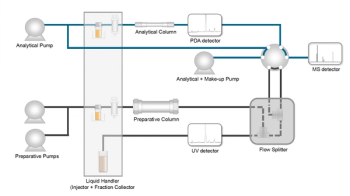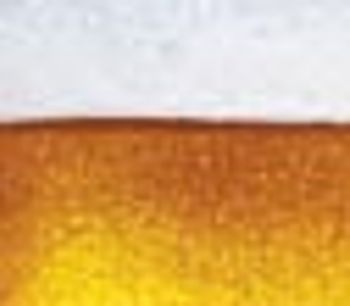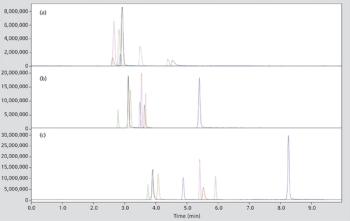
A fast, selective, and quantitative liquid chromatography (LC) method was developed for lipid nanoparticles (LNPs) analysis, using evaporative light scattering for sensitive detection of the analytes of interest.

A fast, selective, and quantitative liquid chromatography (LC) method was developed for lipid nanoparticles (LNPs) analysis, using evaporative light scattering for sensitive detection of the analytes of interest.

This article introduces a multi-step preparative purification workflow for synthetic peptides using liquid chromatography–mass spectrometry (LC–MS). The process involves optimizing separation conditions, scaling-up, fractionating, and confirming purity and recovery, using a single LC–MS system. High purity and recovery rates for synthetic peptides such as parathormone (PTH) are achieved. The method allows efficient purification and accurate confirmation of peptide synthesis and is suitable for handling complex preparative purification tasks.

Analyzing functional foods reveals numerous health benefits. These foods are rich in bioactive compounds that go beyond basic nutrition, boosting the immune system and improving overall wellness. However, analyzing these compounds can be challenging. This article discusses AI algorithms to support automated method development for liquid chromatography, simplifying the process, enhancing labor efficiency, and ensuring precise results, making it accessible to non-experts for tea analysis.

How long should you perform an extraction of woodruff leaves so that you don’t end up with a harmful amount of coumarin, but still get the characteristic flavor of the finished May wine?

A novel analytical method for the analysis of OLED materials using SFC is presented.

OECD-compliant amino acid derivative assay (ADRA) testing and method transfer to UHPLC conditions is presented.

Quantifying the content of coumarin and cinnamaldehyde in cinnamon products

This article introduces optimization of the two separate standard methods, BS148:2009 and ASTM D5837-15, to offer simultaneous analysis in one assay.

An analytical method for the separation of oligonucleotides of different chain length by IEC using a bio-inert UHPLC system is presented.

A high-speed and simultaneous analysis of common active ingredients used in mouthwashes on a C18 column

Partial coelution of chromatographic peaks is an often-encountered issue in high performance liquid chromatography (HPLC) analysis, despite best efforts in method development and optimization. Even though there are several ways of integration of overlapping signals, accurate quantification of single compounds using conventional photodiode array (PDA) detection is almost impossible without baseline separation. While extensive signal processing is well established in spectroscopic analyses such as infrared (IR) or nuclear magnetic resonance (NMR), it has not yet been commonly adapted to improve chromatographic data evaluation. This article introduces the theory and application of a novel data analysis technique for PDA detection to accurately determine and quantify single compounds, even from overlapping peaks, without the need for mass spectrometry (MS) detection.

Quantification of cannabinoids is essential for the accurate labelling of hemp products, both for quality control and for establishing legality with regards to d9-tetrahydrocannabinol (THC) content. For this article, the cannabinoid content of several cannabidiol (CBD)-rich hemp tea samples was determined and was found to often deviate from the content stated on the packaging. Just like the cannabis flower, hemp tea can be analyzed easily and effectively for its cannabinoid content using high performance liquid chromatography (HPLC). The HPLC–UV assay of choice provided good linearity, low limits of detection (LODs), and high precision of retention time and peak area for the 11 cannabinoids under investigation.

The medicinal qualities of cannabinoids contained in hemp have been described in detail. Pain mitigation and reduced severity of nausea and seizures are just a few of the therapeutic benefits reported by medical cannabis patients. There is evidence that a combination of CBD, a host of other minor cannabinoids, and a complex array of terpenoids as contained in hemp oil may be the most beneficial, which is why CBD-rich oil for oral intake has become increasingly popular. The FDA has issued warning letters to firms that market unapproved new drugs allegedly containing CBD. As part of these actions, the cannabinoid content of some hemp products was determined and many were found to contain levels of CBD largely deviating from the label claim. Like cannabis, hemp oil can be analyzed easily and effectively for its cannabinoid content. This article highlights the use of a fast and simple HPLC–UV assay for separation and quantification of 11 important cannabinoids, including CBD in hemp oil.

This article highlights the use of a fast and simple high performance liquid chromatography–ultraviolet (HPLC–UV) assay for separation and quantification of 11 important cannabinoids, including CBD in hemp oil.

The building blocks of peptides and proteins, amino acids, are present in animals, humans, and plants. The analysis of amino acids is of essential significance in several areas including food science, clinical diagnostics, and pharmaceutical products research. Classical liquid chromatography (LC) determination of amino acids is performed with sample pretreatment including pre-column as well as post-column derivatization to improve or enable spectroscopic detection.

This article describes the application of liquid chromatography tandem mass spectrometry (LC–MS/MS) and enhanced multiple reaction monitoring (MRM) spectrum libraries for multi-pesticide residue analysis. Using these methods, a high number of fragment ion transitions of target compounds can be examined to increase specificity and reporting confidence, reducing the risk of false positive or false negative detection.

Analysis of residual antimicrobials in animal products is crucially important to ensure food safety. This article presents a simple, fast, and highly sensitive high performance liquid chromatography (HPLC) assay of regulated antimicrobials, as well as sample preparation and purification methods. Twenty-four different analytes of interest were investigated in beef, pork, and chicken meat samples.

Projects in drug discovery and safety constantly aim at development of novel and safer drugs, therapeutics, and diagnostics. During active pharmaceutical ingredient (API) development, drug stereoisomerism is recognized as an issue having clinical and regulatory implications. Enantiomers have essentially identical physical and chemical properties, while potentially showing large differences in toxicity.

Although ultrahigh-pressure liquid chromatography (UHPLC) method development is fast and cost efficient, many of the analytical methods used in quality control laboratories are still conventional high performance LC (HPLC) separations. Transferring these HPLC methods to UHPLC and validating them is a time-consuming and labour-intensive task. Nevertheless, switching methods from HPLC to UHPLC equipment and vice versa is a powerful tool to increase laboratory efficiency. Modern systems with two flow lines in one system aim to simplify the transition between the two techniques.

Doping and cheating the competition may be as old as competition itself. Doping horses for chariot racing was reported during the Roman Empire and doping is now commonly reported in the press. Advanced technologies such as ultrahigh-pressure liquid chromatography (UHPLC) analysis coupled to ultrafast tandem mass spectrometry (MS/MS) detection provide excellent sensitivity for the analysis of horse doping agents.

A simple, rapid, and robust ultrahigh-performance liquid chromatography (UHPLC) method has been developed for the simultaneous determination of natural and artificial vanilla flavouring substances as well as some precursors has been developed using an automated method scouting or method optimization workflow. The most suitable mobile phase and stationary phase combination was identified in a scouting run. These conditions were used to create a two-dimensional model in computer simulation software. Temperature and gradient time were varied to establish the optimum fast and robust separation conditions. This approach resulted in a 5.5 min gradient method that allowed for fast screening of 11 compounds of interest.

Aflatoxins are poisonous and carcinogenic chemicals that occur in nature in soil, hay, and grains. When contaminated food is processed, aflatoxins can enter the general food supply chain and can be dangerous for humans and animals. Time- and cost-efficient analytical methods can ensure food safety. Compared to conventional manual methods the use of “supercritical” CO2 for supercritical fluid extraction (SFE) as well as chromatographic separation (supercritical fluid chromatography [SFC]) of aflatoxins offers a more efficient process while reducing solvent consumption.

SFE–SFC–MS for the Analysis of Pesticide Residues in Food Products

Amino acids are of vital importance for human life. They serve as transport or storage media for metabolic pathways. Amino acids are components of protein-containing foods such as milk and milk products. Eight amino acids are thought to be essential for humans, meaning that they must be absorbed from foods containing animal proteins or a suitable combination of plant proteins, because the human body can’t synthesize them. Determination of the composition and content of amino acids in milk products is therefore an important measure in ensuring quality and nutritional value.

Beer is one of the most popular drinks in the world. Based on natural products, quality control to guarantee a product of consistent taste, colour, and composition can be challenging. Amino acids analysis can be used to ensure consistency in the quality of the end-product, and also as an indicator for counterfeiting of branded products. In this article we present a rapid and reliable high performance liquid chromatography–mass spectrometry (HPLC–MS) method to determine amino acids in beer.

Accurate steroid measurement is essential for the diagnosis of various disorders, for example in sexual differentiation or gonadal function.

A simple, rapid, and robust UHPLC method for the simultaneous determination of polyphenols, methylxanthines, sweeteners, and flavouring substances as well as some common preservatives has been developed using an automated method scouting and method optimization workflow.


Published: July 8th 2022 | Updated:

Published: July 10th 2023 | Updated:

Published: December 5th 2023 | Updated:

Published: March 9th 2022 | Updated:

Published: September 2nd 2013 | Updated:

Published: June 19th 2014 | Updated: